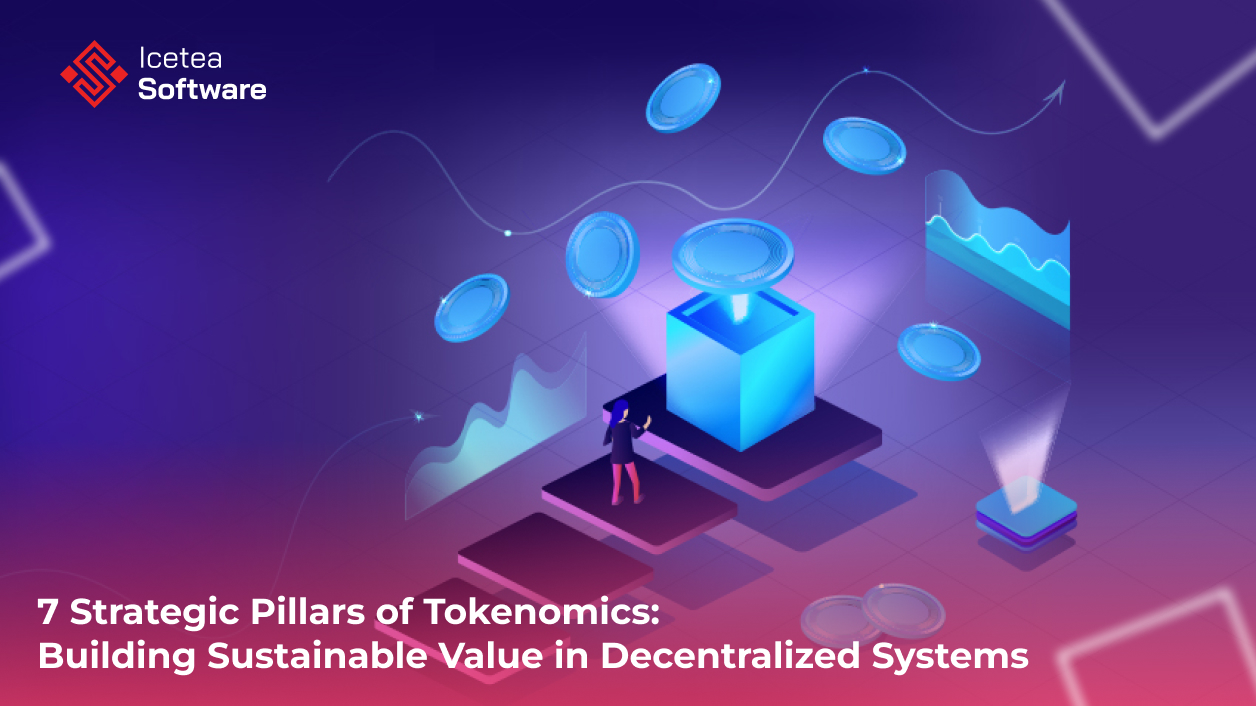7 Strategic Pillars of Tokenomics: Building Sustainable Value in Decentralized Systems
In the rapidly evolving world of blockchain technology, the concept of tokenomics has emerged as a cornerstone for sustainable, valuable, and community-driven ecosystems. Short for “token economics,” tokenomics refers to the design, structure, and functionality of tokens within a blockchain system. It is the framework that defines how tokens are created, distributed, managed, and used—ultimately determining the economic incentives that drive user behavior and project sustainability. As blockchain technology matures and new applications continue to emerge, the role of tokenomics becomes increasingly critical in shaping the value and utility of decentralized systems.
Defining Tokenomics in Blockchain
At its core, tokenomics is the study of economic systems within blockchain networks, focusing on the life cycle of tokens—how they are issued, allocated, and utilized. Tokens within a blockchain ecosystem serve multiple purposes: they can function as a medium of exchange, a store of value, or a unit of account. Additionally, they can grant governance rights, access to specific features, or represent ownership in decentralized protocols.
A robust token economics, model comprises several key components: supply, distribution, utility, and governance. These elements work together to establish the rules and dynamics that govern how value flows within a blockchain network. By designing these components carefully, developers can align the interests of users, investors, and contributors, thereby fostering participation, trust, and long-term commitment.
The power of tokenomics lies in its ability to create and sustain value. When designed effectively, tokenomics can provide both intrinsic and extrinsic incentives that encourage desired behaviors—such as staking, voting, or contributing computing resources. It is a strategic tool that not only guides economic activity but also serves as a blueprint for sustainable ecosystem growth.
The Evolution of Tokenomics in the Cryptocurrency Landscape
The history of token economics is intertwined with the broader development of blockchain and cryptocurrency technologies. Bitcoin, launched in 2009 by the pseudonymous Satoshi Nakamoto, marked the first real-world application of tokenomics. Its economic model was simple yet revolutionary: a fixed supply of 21 million coins, halving issuance over time, and a decentralized network secured through Proof of Work (PoW). This scarcity-based model established Bitcoin as a digital form of gold, emphasizing its value proposition as a store of value.
Ethereum, introduced in 2015, expanded the possibilities of tokenomics by enabling programmable tokens and smart contracts. Through its ERC-20 token standard, Ethereum allowed developers to create and deploy new tokens for decentralized applications (dApps), Initial Coin Offerings (ICOs), and decentralized finance (DeFi) protocols. This ushered in a new era of experimentation with different tokenomics models, each tailored to specific use cases, communities, and governance needs.
Key milestones in token economics evolution include the rise of DeFi platforms, where tokens are used not just for transactions but also for governance, staking, and liquidity provision. Similarly, the emergence of Non-Fungible Tokens (NFTs) introduced new dimensions of value through uniqueness, digital ownership, and provenance. Innovations such as yield farming, liquidity mining, and DAOs (Decentralized Autonomous Organizations) further enriched the tokenomics landscape by integrating complex economic incentives and community governance.
The evolution of tokenomics reflects a growing recognition of its importance. As blockchain networks become more sophisticated and integrated into the real world, their economic models must adapt to new challenges—such as scalability, regulation, and user adoption. Modern tokenomics designs are now increasingly informed by interdisciplinary insights from game theory, behavioral economics, and governance science.
Key Elements of Tokenomics
Understanding the essential components of tokenomics is crucial for designing systems that are fair, functional, and scalable. The primary elements include:
1. Token Supply Supply determines the total number of tokens that will exist. It can be fixed, deflationary, inflationary, or dynamic based on predetermined rules or algorithmic adjustments. The supply model influences the scarcity and, consequently, the perceived value of the token. For example, Bitcoin’s capped supply contributes to its deflationary nature, while some DeFi tokens adopt inflationary models to incentivize early participation.
2. Distribution Distribution refers to how tokens are allocated among users, developers, early investors, and community members. Popular methods include airdrops, mining rewards, staking incentives, and token sales. A well-designed distribution strategy aims to balance fairness, decentralization, and ecosystem security. Centralized distribution can lead to power concentration and undermine trust, while overly fragmented distribution may dilute incentives and governance efficiency.
3. Utility Utility defines the use cases of a token within its ecosystem. A token with high utility provides tangible benefits, such as accessing features, paying for services, or participating in governance. Greater utility typically leads to higher demand, thereby increasing the token’s value and fostering ecosystem engagement. For instance, utility tokens on gaming platforms can be used to buy in-game assets, while governance tokens enable voting on key protocol decisions.
4. Governance Governance encompasses the mechanisms through which decisions are made about the future of the blockchain project. Token-based governance allows holders to vote on proposals, such as upgrades, funding allocations, or policy changes. Effective governance ensures transparency, accountability, and adaptability, encouraging stakeholder participation and long-term alignment.
Mechanisms and Functionalities of Tokenomics
Beyond its components, tokenomics also involves various mechanisms and processes that ensure its functionality. These include:
Token Creation: Typically facilitated by smart contracts, token creation involves defining attributes like supply, divisibility, and roles. Ethereum’s ERC-20 and ERC-721 standards have made token creation more accessible and interoperable.
Token Distribution: Tokens can be distributed through mining (as in PoW networks), staking (in PoS systems), airdrops, or sales. Each method has trade-offs regarding decentralization, fairness, and network security.
Value Generation: A token’s value is derived from multiple factors, including scarcity, demand, utility, and market sentiment. Mechanisms such as token burning (permanently removing tokens from circulation) or buybacks can reduce supply and potentially boost value.
Incentivization: Tokenomics is fundamentally about incentives. Whether it’s rewarding validators in a PoS system, compensating developers, or encouraging liquidity providers, tokenomics must align rewards with the actions that support the network’s health and growth.
Alignment with Protocols: A successful tokenomics model must be compatible with the blockchain’s consensus mechanism and technical architecture. For example, PoW and PoS systems require different economic incentives to ensure security and liveness.
Tokenomics and Market Dynamics
Tokenomics plays a pivotal role in shaping market behavior. It affects how tokens are valued, traded, and perceived. For instance, a limited supply can create scarcity and drive up prices, while inflationary models might keep prices stable but reduce long-term holding incentives. Similarly, vesting schedules and lock-up periods affect liquidity and investor behavior.
Furthermore, tokenomics can directly influence user engagement. Staking rewards, governance participation, and gamified incentives can encourage users to remain active in the ecosystem. Poorly designed tokenomics, on the other hand, can lead to speculative bubbles, dumping, and rapid community disengagement.
In DeFi, for example, the rise of yield farming and liquidity mining showed how token incentives can drive massive capital inflows—though sometimes at the cost of sustainability. As such, designing resilient tokenomics requires balancing short-term growth incentives with long-term viability.
Challenges and Future Directions
Despite its transformative potential, tokenomics faces several challenges. These include:
- Regulatory uncertainty: Token classification (utility vs. security) affects compliance and legal risks.
- Speculation vs. utility: Many tokens are traded for speculative gains rather than used within ecosystems.
- Complexity: Designing tokenomics requires deep knowledge of economics, technology, and community behavior.
- Security vulnerabilities: Poorly implemented smart contracts or incentive models can lead to exploitation.
Looking ahead, the future of tokenomics will likely include more adaptive, data-driven models. Innovations such as algorithmic governance, dynamic incentives, and reputation-based systems are being explored. Additionally, integrating off-chain data and AI into tokenomics could enhance personalization and responsiveness.
Sustainability and inclusivity will also be central to future tokenomics. Projects will need to design models that are accessible to diverse users and resilient in the face of market volatility. Interoperability across chains, improved governance models, and transparent economic data will be key areas of focus.
Final Thoughts
Tokenomics is not just a buzzword—it is the engine behind every successful blockchain ecosystem. From Bitcoin’s scarcity model to Ethereum’s programmable tokens and DeFi’s complex incentive structures, tokenomics has proven essential in creating value, driving innovation, and fostering community. As the blockchain space continues to evolve, so too will the sophistication and significance of tokenomics.
By thoughtfully designing supply, utility, distribution, and governance, developers can build ecosystems that are not only technically robust but also economically sustainable. In a decentralized future, where trust is algorithmic and value is digital, tokenomics will be the language through which we design, distribute, and democratize value.
————————————
𝐈𝐜𝐞𝐭𝐞𝐚 𝐒𝐨𝐟𝐭𝐰𝐚𝐫𝐞 – 𝐂𝐮𝐭𝐭𝐢𝐧𝐠 𝐄𝐝𝐠𝐞 𝐓𝐞𝐜𝐡𝐧𝐨𝐥𝐨𝐠𝐢𝐞𝐬
𝐖𝐞𝐛𝐬𝐢𝐭𝐞: iceteasoftware.com
𝐋𝐢𝐧𝐤𝐞𝐝𝐢𝐧: https://www.linkedin.com/company/iceteasoftware/
𝐅𝐚𝐜𝐞𝐛𝐨𝐨𝐤: https://www.facebook.com/IceteaSoftware/
𝐓𝐰𝐢𝐭𝐭𝐞𝐫: https://x.com/Icetea_software








